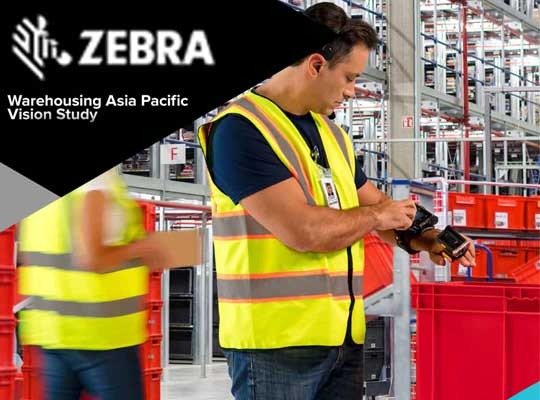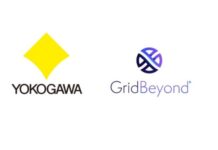NEW DELHI, India – September. 24, 2019 – Zebra Technologies Corporation, today announced the results of its latest Warehousing Asia Pacific Vision Study.
The study analyzes IT and operations decision makers from manufacturing, transportation and logistics, retail, post and parcel delivery and wholesale distribution industries for their current and planned strategies to modernize warehouses, distribution centers and fulfillment centers.
“Warehousing, distribution and fulfilment operations are undergoing a modern-day makeover as they transform to meet the growing needs of the world’s on-demand economy. Warehouse leaders today are turning to technology to address business critical challenges resulting from this global phenomenon, by adopting advanced technology and empowering their workers with a performance edge,” said Aik Jin, Tan, APAC Vertical Solutions Lead, Manufacturing and Transportation & Logistics, Zebra Technologies. “Expanding space, implementing new processes and enhancing workflows are only part of the equation. By 2024, warehouse leaders will be shifting their focus to the integration of more holistic solutions to build data-powered environments that balance labor and automation in the warehouse, ultimately empowering front-line workers with a performance edge to lead the way.”
The study reports on the forward-thinking fulfillment strategies that companies are focusing on to keep up with the growth of the on-demand economy. Both automation and worker augmentation solutions will be a key focus for decision makers’ plans over the next five years. More than three-quarters (81 percent) of respondents agree that augmenting workers with technology is the best way to introduce automation in the warehouse, but only 34 percent have a clear understanding of where to start automating. Currently, up to 88 percent of decision makers are either in the process of or are planning to expand the size of their warehouses by 2024. Meanwhile, up to 85 percent anticipate an increase in the number of warehouses during this timeframe.
“Consumers today have seemingly insatiable demands for 24/7 product search and purchase. The ‘I want it now’ mentality of consumers stretches across all industries and have since upended the supply chain, impacting manufacturers, retailers and the warehousing operations that serve their needs,” said Deep Agarwal, Regional Sales Director of India, Zebra Technologies. “Our study further revealed that 49 percent of the surveyed decision makers reported an increase in consumer demand as a top driver for growth, with almost 40 percent of those surveyed stating that shorter order lead times are fueling their expansion plans and causing them to rethink their strategies.”
“To match up to the on-demand mentality of consumers, decision makers will need to quickly train their front-line workers to fill orders more efficiently. Outdated Windows® devices running green-screen applications are not designed to match the speed and volume of today’s on-demand economy. Conversely, modern Zebra Android touch-screen devices like the MC9300, MC3330R and MC3390R are designed for faster, more flexible operation that improves warehouse performance to meet the expectations of demanding consumers today,” added Aik Jin, Tan.
KEY SURVEY FINDINGS
By 2024, automation will enhance worker performance rather than replace workers.
- 57 percent of decision makers plan to enable partial automation or labor augmentation with technology in the warehouse.
- 70 percent of respondents believe human interaction is part of their optimal balance in warehousing, with 43 percent citing partial automation (some human involvement) and 27 percent citing augmentation (equipping workers with devices) as their preference.
- Decision makers anticipate using robotics for inbound inventory management (27 percent), packing (24 percent) and goods in/receiving (21 percent) by 2024.
Rethinking fulfillment strategies and operations to meet emerging challenges across the warehouse remains a top priority.
- 68 percent of respondents cited capacity utilization as one of their top expected challenges over the next five years.
- 68 percent of organizations cited labor recruitment and/or labor efficiency and productivity among their top challenges, with 62 percent of respondents wanting to improve individual worker or team productivity today while also achieving workflow conformity.
- IT/technology utilization was identified both as the biggest operational challenge (68 percent) within the next five years and a desired long-term outcome for increased asset visibility, real-time guidance and data-driven performance.
- As warehouses expand, so will the volume of stock keeping units (SKUs) and the speed items need to be shipped. Decision makers will seek increased visibility and productivity by implementing more robust returns management operations (85 percent), task interleaving (85 percent), value-added services (84 percent) and third-party logistics (88 percent).
The investment and implementation of new technologies is critical for remaining competitive in the on-demand economy.
- Almost half (48 percent) of surveyed respondents cited faster delivery to end-customers as the primary factor driving their warehouse growth plans.
- Three-quarters (75 percent) of decision makers agree that they need to modernize warehouse operations to remain competitive in the on-demand economy but are admittedly slow to implement new mobile devices and technology.
- 73 percent of companies are currently modernizing their warehouses by equipping workers with mobile devices. By 2024, modernization will be driven by Android-based mobile computing solutions (90 percent), real-time location systems (RTLS) (60 percent) and full-featured warehouse management systems (WMS) (55 percent).
- 66 percent of respondents cited mobile barcode label or thermal printers as a key area of investment as part of their plans to add, expand or upgrade devices in the next three years.
In tandem with the developments of the warehousing industry, Zebra has launched four new products; the MC9300 Ultra-rugged Mobile Touch Computer, the MC3330R Integrated UHF RFID Handheld Reader, the MC3390R Integrated Long-Range UHF Handheld RFID Reader, and the ZT600 Series Industrial Printer.
KEY FACTS – MC9300 Ultra-rugged Mobile Touch Computer
- Maximum processor power and memory for ultimate performance with an ultra-powerful 8-core processor combines with up to eight times the RAM and 16 times the Flash memory of the MC9200 to deliver superior performance on all voice and data applications.
- Impressive battery life thanks to the PowerPrecision+ battery that delivers the most battery power in its class that comes with faster charging and a wealth of battery statistics for optimal battery pool management.
- Superior WiFi connections for optimal mobile productivity with 2×2 Multiple-User Multiple Input Multiple Output (MU-MIMO) technology and WorryFree WiFi, a free Mobility DNA tool whereby customers can enjoy increased WiFi range and speed, near instant application response times, unmatched roaming, exceptional voice quality and network diagnostics that help keep WiFi networks up and running at peak performance.
- LifeGuard™ for Android™ which extends the effective device lifespan by allowing customers with the security updates to keep Zebra devices secure every day they are in service—along with end-to-end control of the OS update process. It is also built-in support for the next two versions of Android (P and Q) to help keep devices in service longer for a future-proof investment.
KEY FACTS – MC3330R Integrated UHF RFID Handheld Reader
- Best-in-class mid-range RFID read performance with a powerful Android platform.
- Rugged and ready for all-day use thanks to a higher 5 ft./1.5 m drop specification and IP54 sealing that can handle splashing liquid and dust; the Corning Gorilla Glass touch panel and imager window bring maximum scratch-resistance and shatter-proofing.
- Extraordinary RFID performance that offers greater flexibility, speed and accuracy thanks to its integrated circular antenna that delivers extraordinary reliability no matter the orientation of the tag.
KEY FACTS – MC3390R Integrated Long-Range UHF RFID Handheld Reader
- Best-in-class RFID read range and accuracy that can capture RFID tags more than 60 ft./18.2 m away.
- The perfect combination: large touchscreen and keypad; the MC3390R has the largest touchscreen in its class for easier readability and more intuitive touch-based interactions.
- Extended battery life thanks to its high capacity, field-replaceable PowerPrecision+ battery that can last more than five hours with typical use.
KEY FACTS – ZT600 SERIES INDUSTRIAL PRINTER
- Unparalleled Performance that supports the most versatile needs of any industrial printer, making it ideal for high volume, high-speed applications. It also supports high-resolution printing for micro-label applications, such as circuit boards, chips, miniature components.
- Built to withstand demanding industrial conditions for 24/7 reliability, it has built-in thermal management and the ability to withstand years of exposure to dust, debris and extreme temperatures.
- Hassle-free setup and operations thanks to its color graphic display with intuitive icon-based UI. It has simple intuitive side loading with LED illuminated media path, complete with onboard sensors, diagnostics and help resources to assist with troubleshooting.
For more information, visit www.zebra.com















